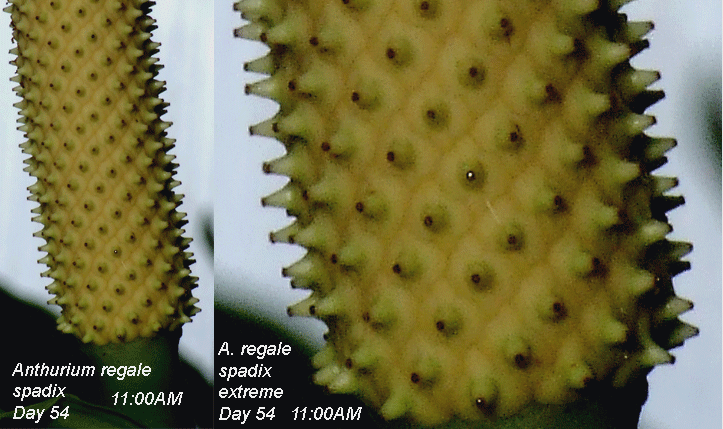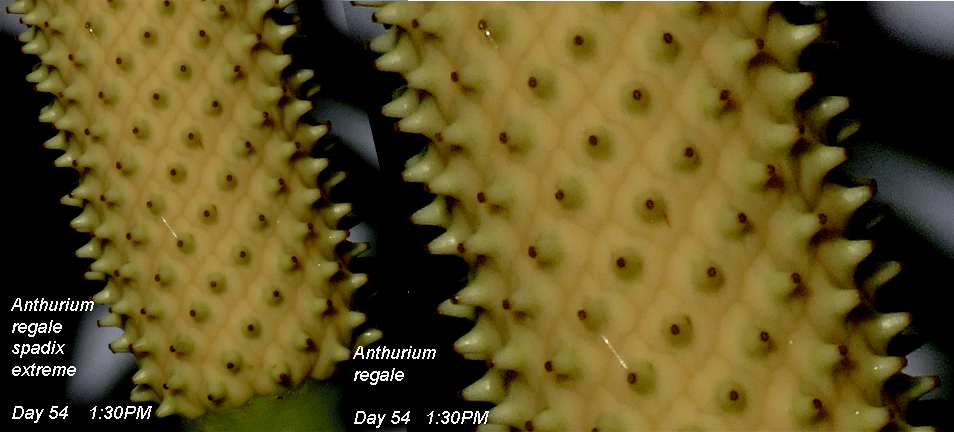![]()
Aroids and other genera in the Collection
Take the Tour Now?
Orchids
The
Exotic Rainforest
Plants in
the Exotic Rainforest Collection
Images on this website are copyright protected. Contact us before
attempting to reuse.
Anthurium regale
Linden
Growth of an
inflorescence
Please note:
This page contains numerous photographic images.
If you are using a dial-up connection the time may be longer
than expected.

Photos ©
2006/2007 Steve Lucas
Growth of an inflorescence
See Page 2 for the definitions of botanical terms used in this description.
Anthurium regale spathe and spadix Page 4 Day 32 through 44
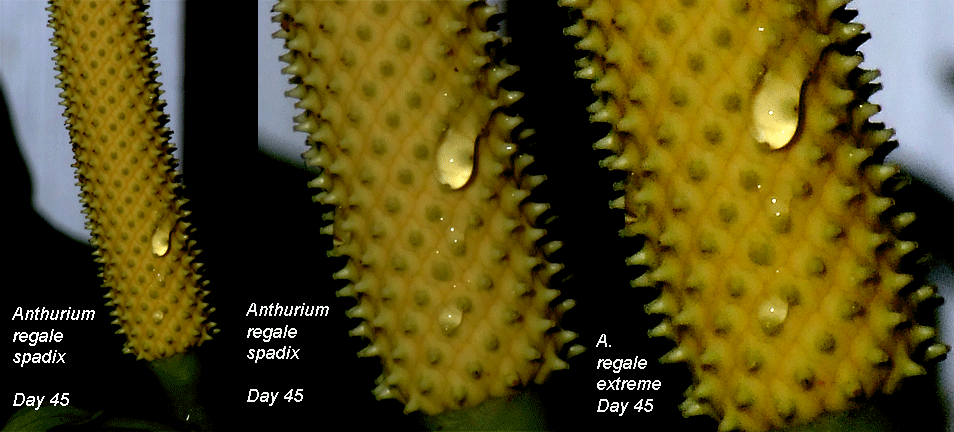


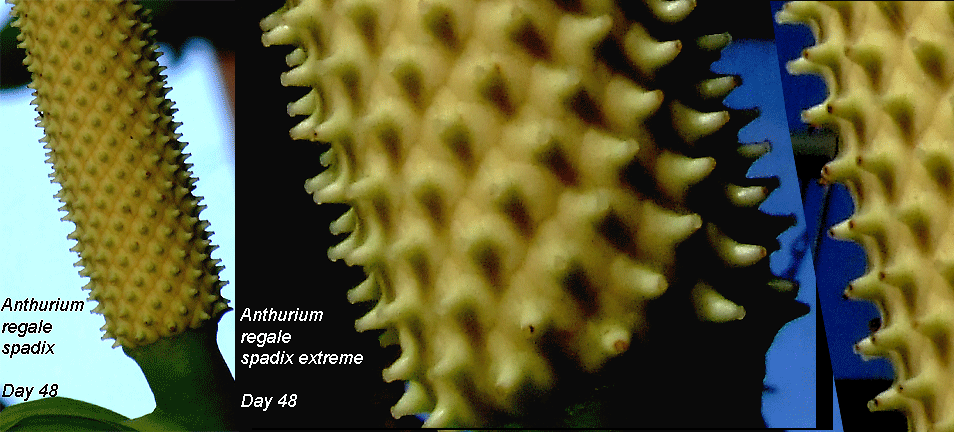
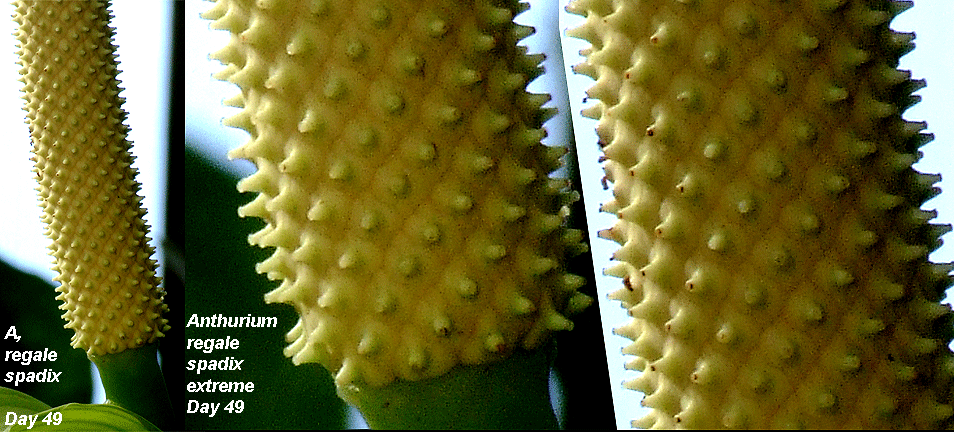

Day 50: Dr. Croat has prompted me often to try to observe and describe the scent. Finally, today the spadix is fragrant. Very fragrant! The scent is similar to a light sweet perfume. The spadix has now turned ivory, much lighter than 3 days ago, however stamens still cannot be observed. The water droplets fall from the ceiling and are a result of high humidity in the atrium. Once Dr. Croat reminded me, it is now obvious many of the stigmas have not yet dried. Perhaps what we thought was the beginning of anthesis some weeks ago may have been a false alarm! Or perhaps, anthesis is simply a slow process for this species. The key may have been the color change. When I informed Dr. Croat of the long awaited scent he responded, "I am glad to hear that the presence of seemingly receptive stigmas is associated with the presence of an aroma. That is the normal pattern. At what time of the day does the scent occur? The timing and duration of the scent? This is perhaps the best indication of the actual timing of pollination. Some species have scent for only a short time, sometimes early in the morning. I know of a species that produces scent only between 11:00AM and 1:00 PM. It just turns out that this is the time of day when the weather for pollination is best because it is often raining at other times." In the case of this Anthurium regale spadix the scent was first noticed at approximately 11:00AM and again at 1:30PM. Tomorrow I will check more often in an attempt to learn the exact times and duration.

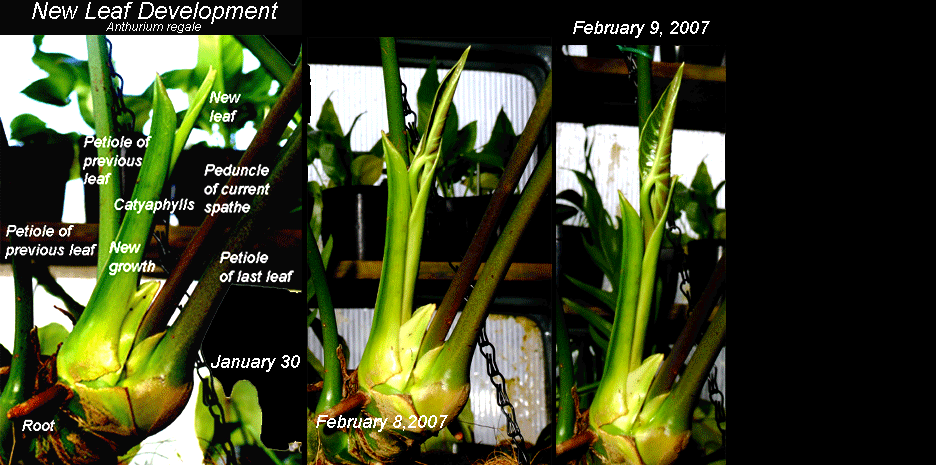
By day 52 the new leaf has extended from 11 cm (4 5/16th inch) to 17cm (almost 6 3/4 inches). In 9 days it has increased in length 6cm (approximately 2 3/8th inches). All portions of the catyaphylls are now visible.
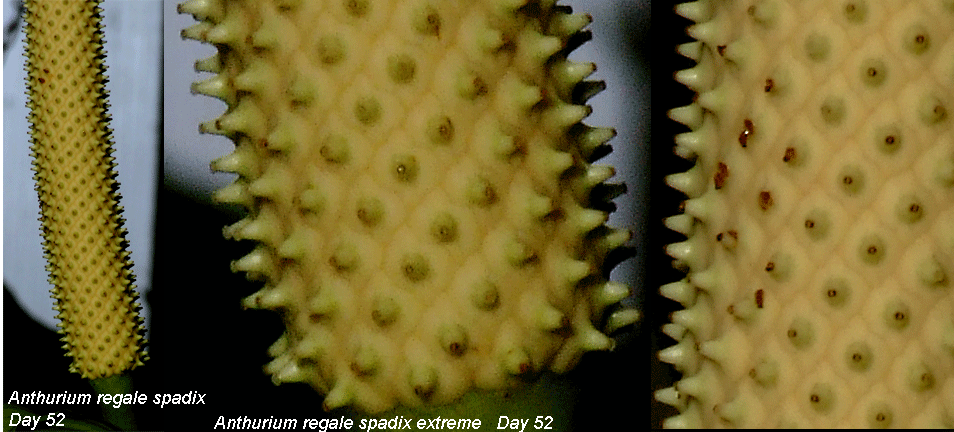
Day 52: Several interesting observations were made today. First, the fragrance is only faintly apparent at 11:30AM. On both previous days it was very noticeable by 11:00AM. The only difference today is the sun's intensity. Both of the previous days were bright and sunny, today it is overcast. Could A. regale be responding to the intensity of the light? By 12:00 noon the scent was increasing in strength, but still not as strong as midday yesterday. By 12:45PM the fragrance was slightly more fragrant but still not as intense as yesterday. At 1:30PM the scent was again growing faint and by 2:45PM had again vanished. Is the plant avoiding attempting to attract pollinators since low light levels may indicate it might rain? I am simply speculating since the answers will be found by someone with more scientific expertise.
Second, the stigmatic hairs are visible near the bottom of the spadix. However, approximately 1/3rd up the spadix (see second extreme photo), in the region where the stigmas are damaged, few stigmatic hairs can be observed? Why? The second extreme photo was taken at a 45 degree angle to the left of the view normally shown. And still, no stamens can be observed. The coloration of the entire spadix is now noticeably brighter, approaching white. Is the "white" coloration the actual visual key to the start of male anthesis and the production of stamens followed by pollen?
After reading my questions regarding the lack of and/or reduction of scent today in relation to the sunlight, as well as my comments on the stigmatic hairs, Dr. Croat had this response, "I do think that the sun might well have an effect on the production of the pharamone (scent) and it may not have anything to say about whether the climate might produce rain. The stigmatic hairs should not be more receptive at the base of the spadix than at the middle except in a few rare cases where the lowermost flowers are not the first to emerge. It is interesting that you still have no stamens developing. I have seen this happen before where stamens never emerge and I can't explain it. I sometimes wonder if some species are not becoming dioecious, ie. producing male and female plants. It has never been proven to happen in Anthurium but in Arisaema we do know that it can happen."
In regard to my possible
misreading of the timing of female anthesis, Julius wrote an
interesting note to both Dr. Croat and myself this morning
(February 8, 2007).
In it he said,
"This whole
exercise by Steve has been most interesting, and a lot based
on speculation! I too can not be absolutely certain of
when or even if the female anthesis began. But based
on past experiences, the stigmas were dry during development
of the infloresence and the opening, then reflexing of the
spathe, then the drops of liquid began appearing on their
tips (I assumed that this signaled female anthesis), this
liquid then dried up, and at that
point you were able to observe the stigmatic hairs (as there
was no longer any liquid on their tips, the color changes
began around this point??), and only then did Steve detect
the fragrance, so I assumed the fragrance was being produced
at or near the start of male anthesis."
Julius is far more experienced
in the observation of anthurium reproduction behavior than
I, but it appears we may have been fooled by the behavior,
or the misinterpretation of the behavior, of Anthurium
regale. Obviously, I still have a lot to
learn! Perhaps all of us have a lot to learn!
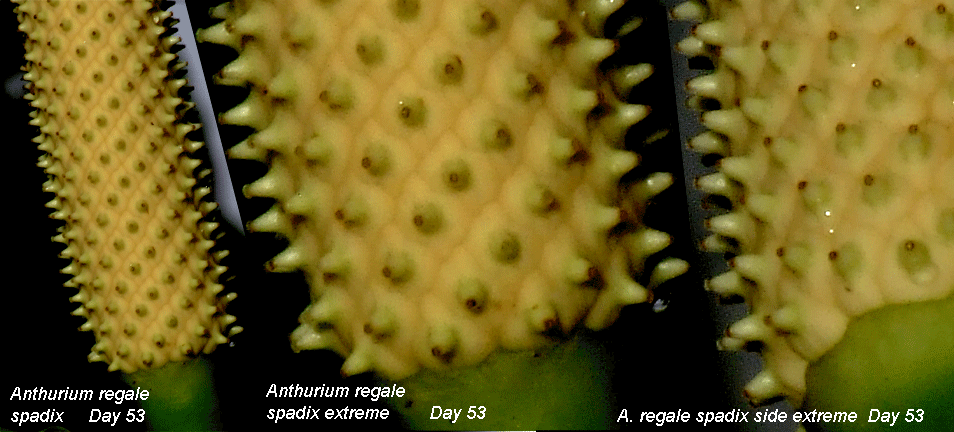
Day 53: The sky is again overcast. And again, apparently responding to the low light level, the spadix was slow to produce pheromones (scent). The scent did not begin to appear until almost 12:00 noon and did not become truly apparent until almost 1:00 PM. At 1:30 PM the fragrance was still quite vague and by 2:15 PM was hardly noticeable. When examining the photographs a puzzling observation became apparent. A few "wet" spots were visible on portions of the spadix but did not appear to be water droplets from the ceiling. When you look at the center photograph, lower right, you'll see moisture. Tiny droplets can be seen at other places on the spadix and were much smaller than on previous days when water droplets had fallen from the ceiling. As a result I elected to photograph the spadix from the right side. No major water droplets were visible. Instead, there are very tiny drops of moisture beneath several perigones.
If you have been following this discussion you are aware
I, along with several observers, felt female anthesis was completed
several weeks ago. But male anthesis has not appeared
to begin. Why? We have not been able to
observe any stamens appearing from the center of the
stigmas. Why? Is this one of the species that
does not produce obvious stamens? Dr. Croat has expressed the
opinion anthesis may have only recently begun. Are these
droplets a result of the female anthesis Julius explained would eventually begin and I assumed had
already happened? Are we still
days away from male anthesis? Another interesting
observation that caught my attention.... the stigmatic hairs can be seen at least
half way up the spadix, yesterday they were visible only
part of the way up. They are quite visible in both
extreme photographs. Honestly, I don't know for
certain what is
happening! I'm just a curious untrained observer with
camera in hand and more questions than answers. But as
I commented yesterday, perhaps we still have a great deal
more to learn about this species.
And for those of you reaching for a
dictionary here is the definition of the word you are about
to look up:
Senescence (si-NEH-suhnts):
Aging, the state of being old; the process of growing old.
